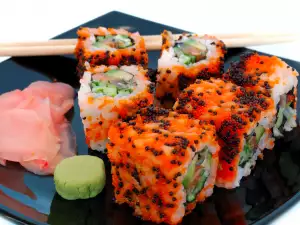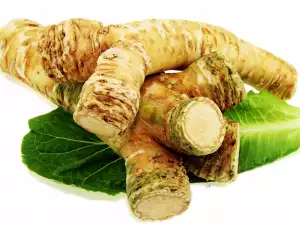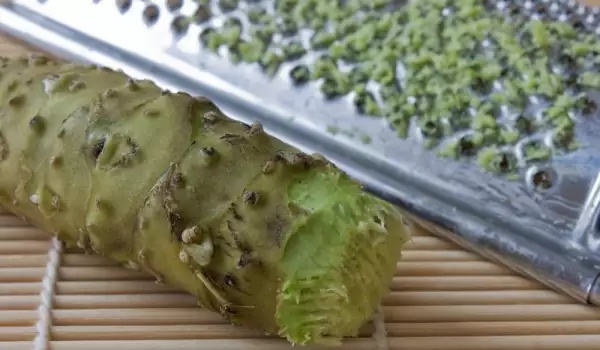Wasabi is also known as Japanese horseradish. It's kind of a light green color Japanese condiment. Wasabi is often in the form of mustard with a strong and pungent, but relatively short-lived taste. Wasabi is a spicy green sauce, which is served with sushi and sashimi.
Wasabi is made from a plant resembling horseradish and is traditional, most commonly being used to flavor sushi. Unlike sauces that are based on an extract of chili, the chili effect of wasabi is fleeting.
The plant's root that has been known since 1396, when residents of the Sidzuoka area served it as a gift to their future shogun. After this point, the plant spread to other parts of Japan and began to be cultivated at home. Wasabia japonica is a perennial aromatic herb. It reaches 45 cm in height with leaves and heart-shaped white flowers. It blooms in April and May, it’staste qualities are distributed in the roots and their upper part is hot. After half a year, the rhizome begins to expand and then they can reach 5-15 cm
In Japan, it’s called hong wasabi and can only be found there. It grows in the special conditions in running water and temperature 10-17 ° C. Most often outside of Japan, they do not use the real plant, a spice is made from wasabi, called daikon. This vegetable is transported from Japan to Europe. Unlike the original wasabi, its counterpart is white, which requires the addition of a green colorant. This happens because the original root is quite expensive - the price varies from 200 to 500 Eur/kg, and it is difficult to grow. It grows only in five regions of Japan.

Composition of wasabi
Wasabi contains large amounts of provitamin A, glycosides, vitamins of the B group, vitamin C and minerals, which are mainly sulfur. 100 g wasabi contains 109 kcal.
Selection and storage of wasabi
In most places, the consumption of sushi is already widespread, so wasabi is found in many stores. It should be stored in a dry and cool place. Once opened, it should be stored in the refrigerator and used within one month.
Wasabi in cooking

Wasabi paste is made from the grated root. As a rule, the plant is grated only as much as is needed at the moment, and the rest of the root is stored in the refrigerator, because the taste of wasabi is quite perishable and it can lose it’s aroma within 15 minutes. In the preparation of sushi, between rice and fish, they help it retain its flavor longer. Wasabi is used as an additive for sandwiches and other sauces, but the market is now even offering peanuts with wasabi. Traditionally, an addition for wasabi is Japanese sake.
Combined with mayonnaise, wasabi is a great addition to eggs and cold meats. Wasabi combined with ginger sauce, fresh coriander and garlic is used as a marinade for steaks.
In Japanese tradition, wasabi roots are cleaned with a brush, peeled and shredded. Some Japanese sushi masters used only graters made of shark skin, rather than ordinary ones. They believe that the grating with sharkskin gives amazing flavor to the wasabi paste.
Benefits of Wasabi
Using Hong wasabi has the ability to protect you against tooth decay. Wasabi has strong antibacterial properties that are particularly useful when using raw fish. Wasabi is a valuable drug, because it has the unique property to stop the multiplication of cancer cells.
Wasabi japonica has strong healing properties and is considered one of the factors of the famed Japanese longevity. The root has anti-allergic, anti- asthmatic and even anti-anaphylactic properties, making it an excellent assistant of patients with asthma. Wasabi also has antimicrobial and Slimicide actions, obliterating the deadly staph and E. coli (Escherichia coli). Wasabi kills the dangerous Helicobacter Pylori, which causes ulcers and stomach cancer.
Furthermore, wasabi has anticlotting action that prevents the formation of blood clots. With regard to the treatment of cancer, wasabi is involved in blocking metastasis, and at a later stage- the destruction of cancer cells, without damaging normal ones. In this respect, wasabi is a powerful tool to patients with leukemia and breast cancer, bladder, prostate, pancreas, lung and colon problems. Wasabi is useful in diabetes and has a detoxifying effect.
















